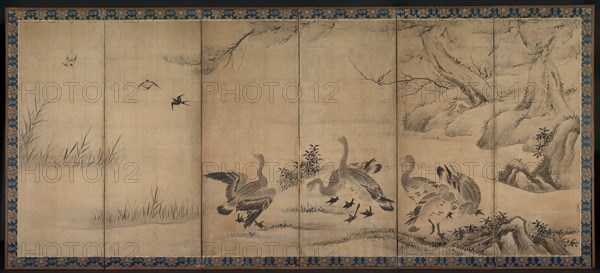
Sujet
Wild Geese, late 1500s-early 1600s. Creator: Kano Sanraku (Japanese, 1559-1635).
Légende
Wild Geese, late 1500s-early 1600s. Depictions of geese usually appear as ink paintings in Japan during the 1200s. They later show up in the colourful landscapes of illustrated handscrolls. Such early ink renditions of the birds have long been associated with classical Chinese Zen painting and poetry, which was avidly admired and collected in medieval Japan. In these screens the artist portrayed the waterfowl in a pastoral setting without reference to classical or religious themes. Such ordinary subjects were imbued with special meaning in 14th- and 15th-century Japan through associations with continental culture, Zen thought and poetry, and famous Chinese monk-painters whose painting techniques had become revered as visual emblems of Zen principles. The screens here reflect the continuation of that painting tradition in the late 1500s or early 1600s by the head of the most important studio in Kyoto. Sanraku also executed a number of colourful folding screen compositions, but here he pays homage to the style of early Zen painting.
Date
0
Crédit
Photo12/Heritage Images/Heritage Art
Notre référence
HRM19G19_359
Model release
NA
Property release
NA
Licence
Droits gérés
Format disponible
363,6Mo (11,4Mo) / 141,4cm x 64,4cm / 16699 x 7610 (300dpi)